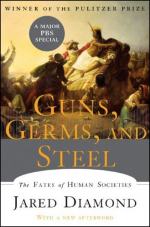|
This section contains 614 words (approx. 2 pages at 400 words per page) |

|
Chapter 9 "Zebras, Unhappy Marriages, and Anna Karenina" Summary and Analysis
While smaller mammals, such as rodents, dogs, chickens, and so on, have been kept by many societies around the globe and used for food, clothing, and warmth, none of these smaller animals have been used in agriculture or war. Only fourteen big mammals species, sheep, goat, cow, pig, horse, Arabian camel, Bactrain camel, llama and alpaca, donkey, reindeer, yak, Bali cattle, mithan, and water buffalo, were domesticated before the 20th Century. Additionally, only five of these species were being widespread and seen as important around the world: cows, sheep, goats, pigs, and horses. Diamond defines a domesticated animal as one bred in captivity and that has somehow been modified from its wild ancestors. The wild ancestors of these species were spread unevenly across the globe...
|
This section contains 614 words (approx. 2 pages at 400 words per page) |

|




